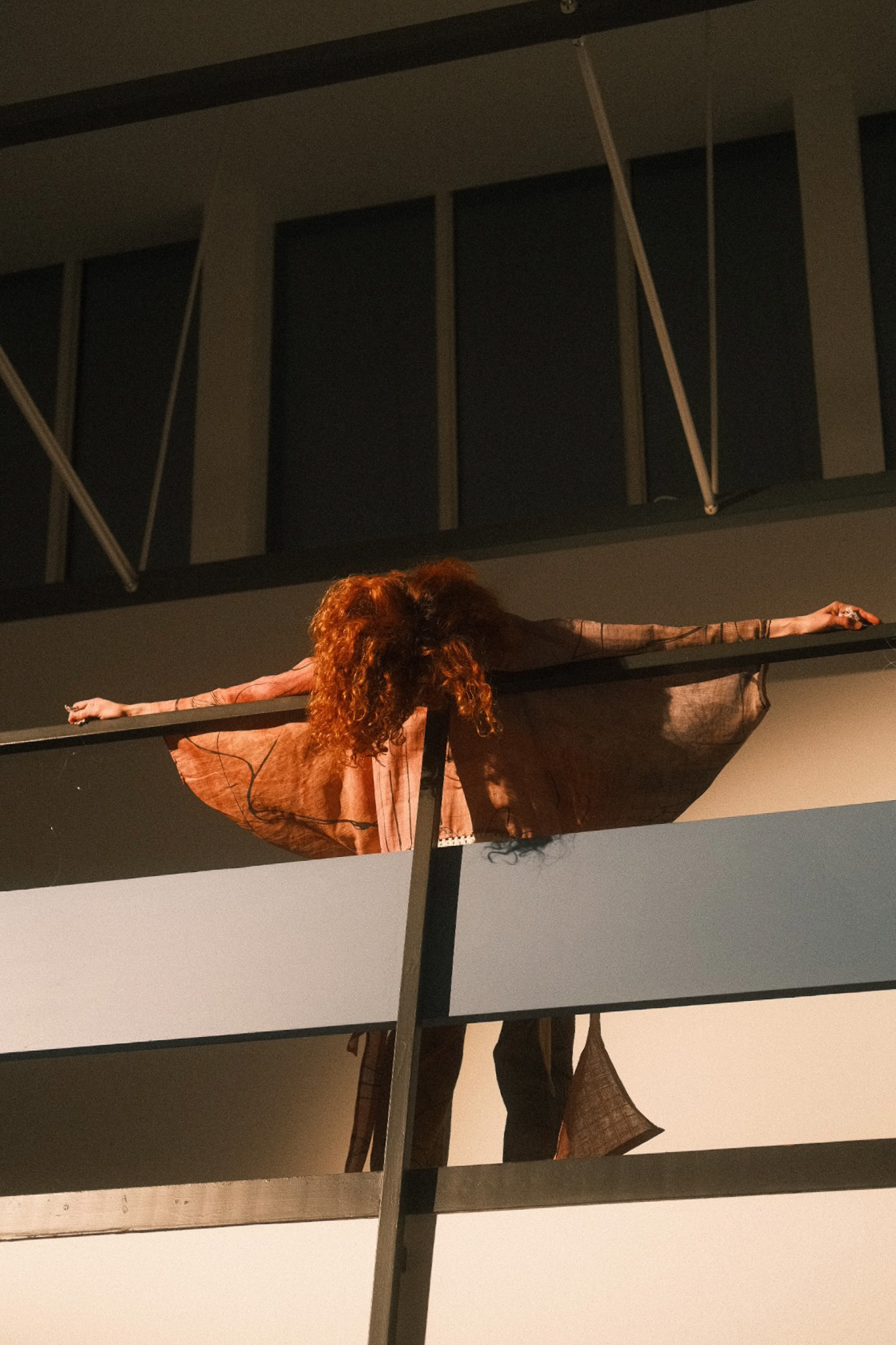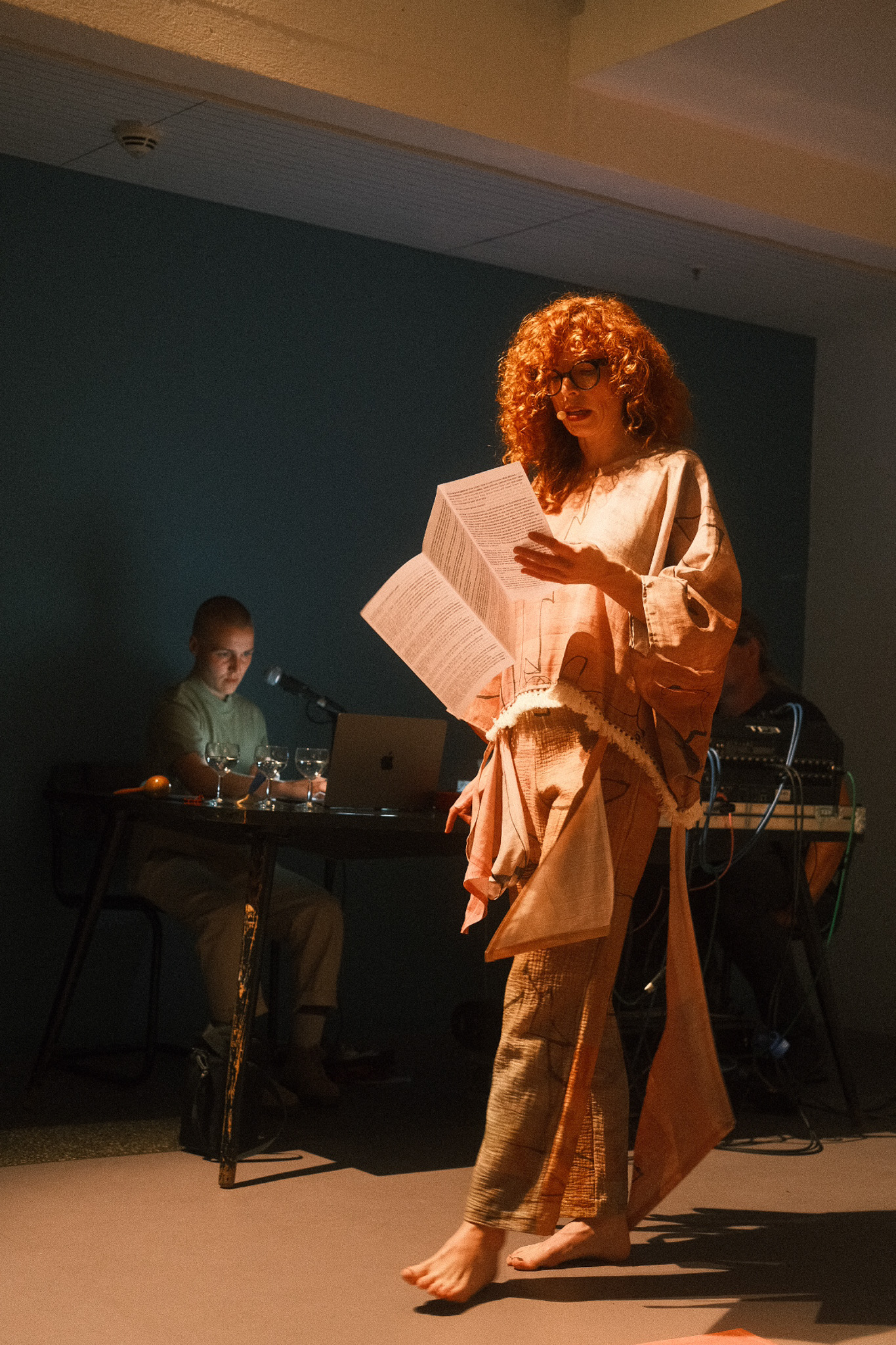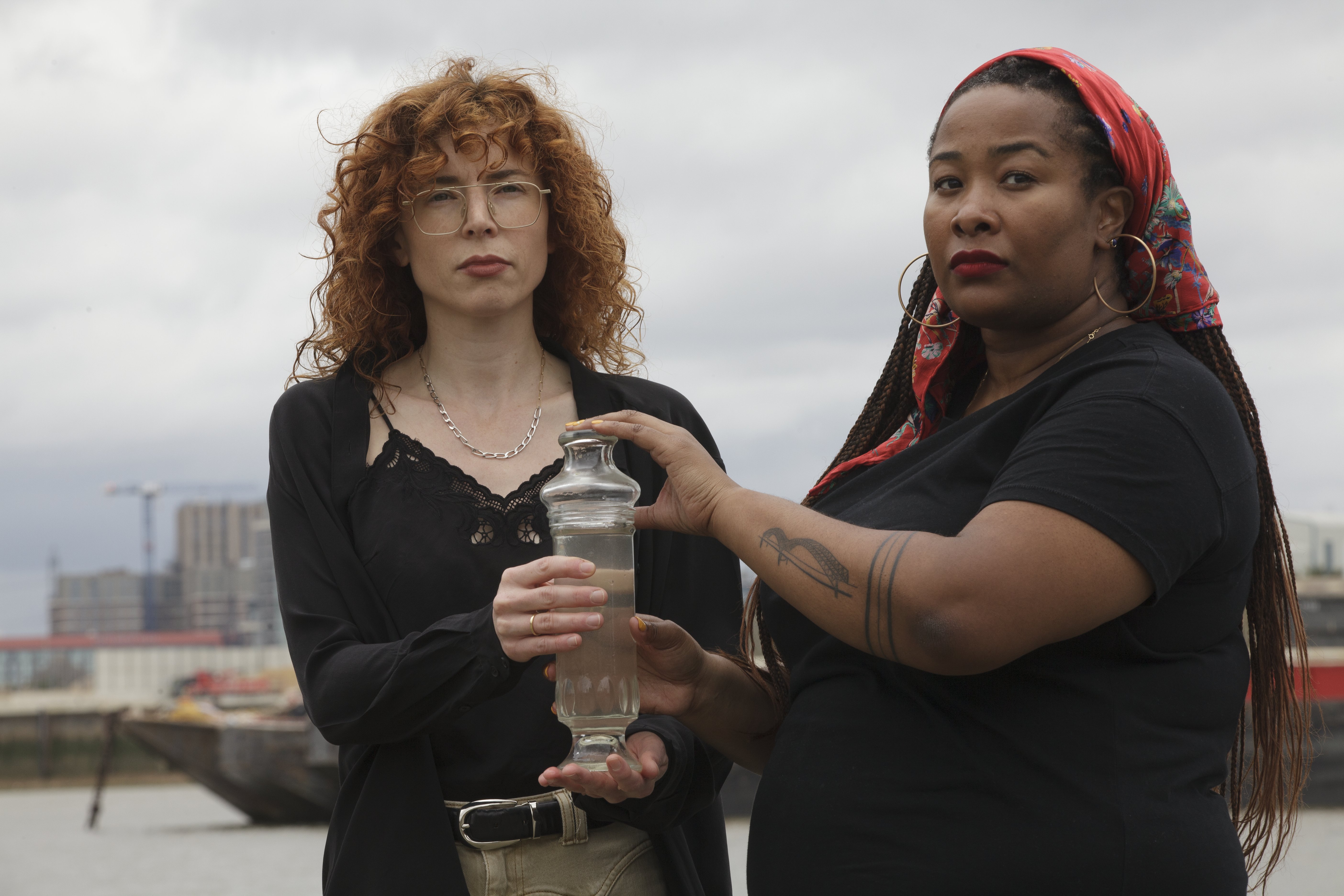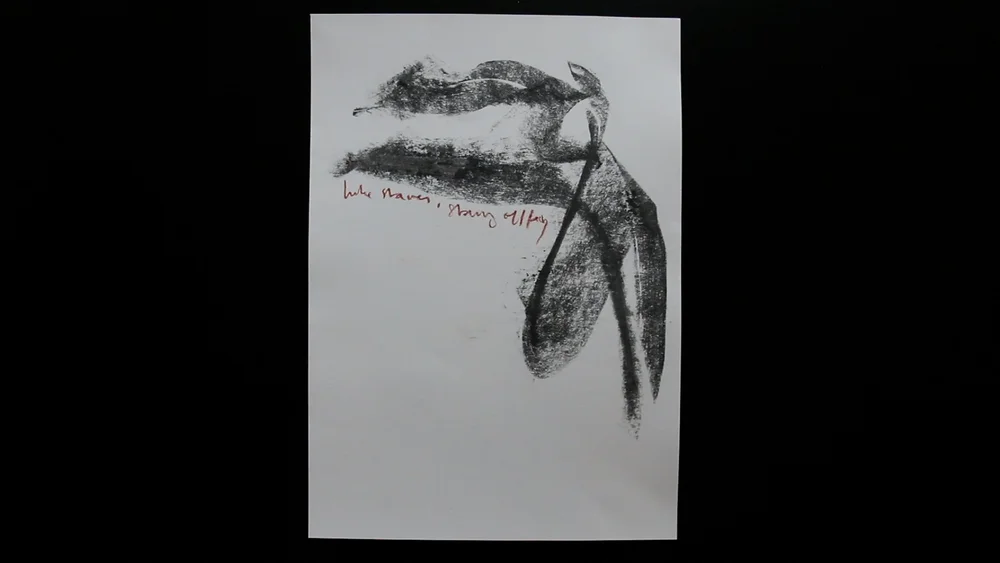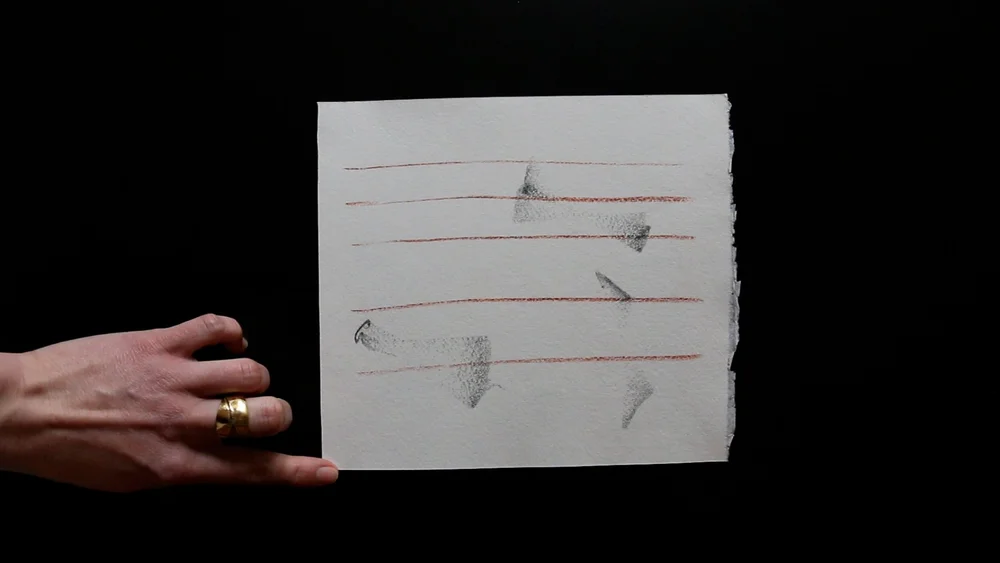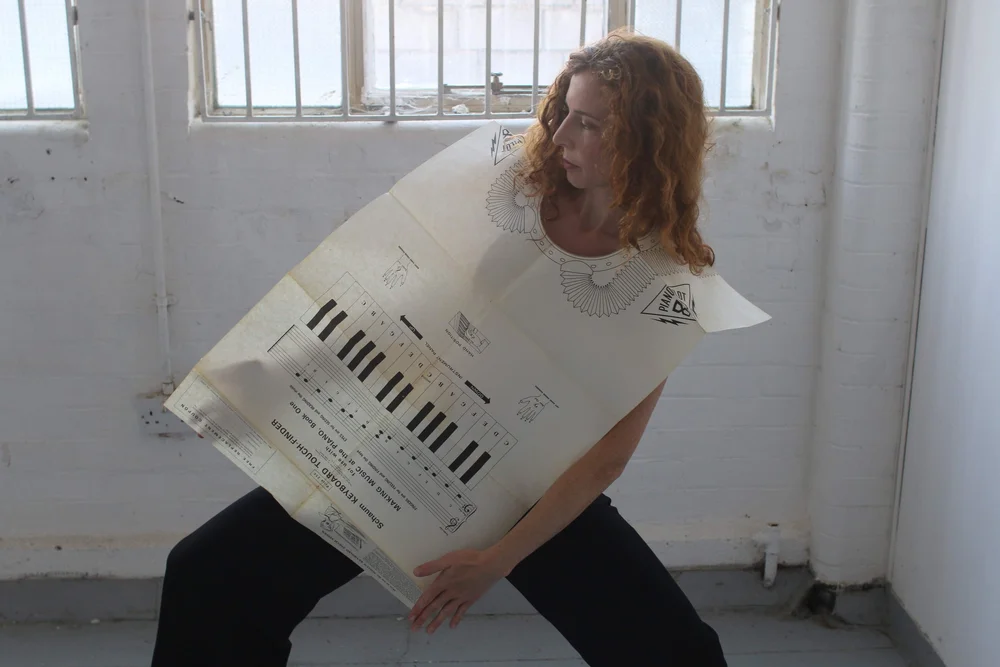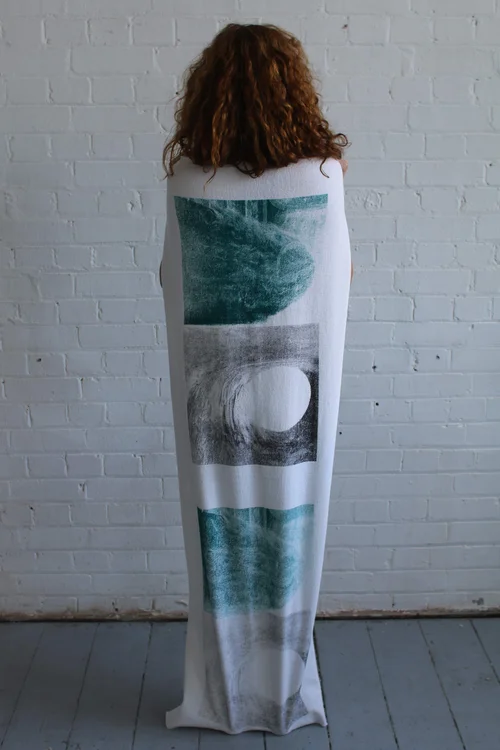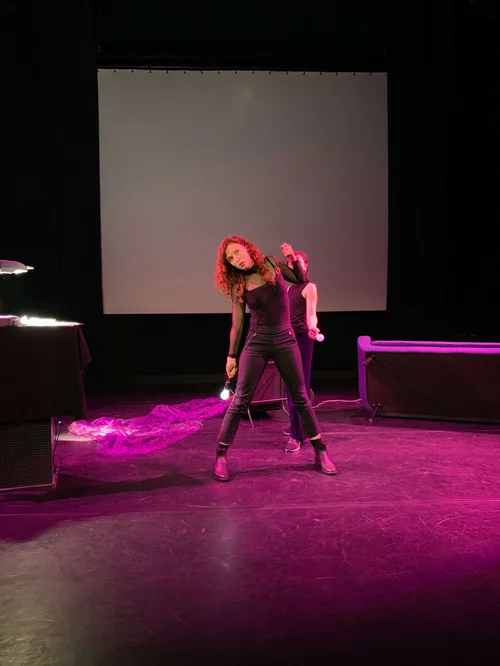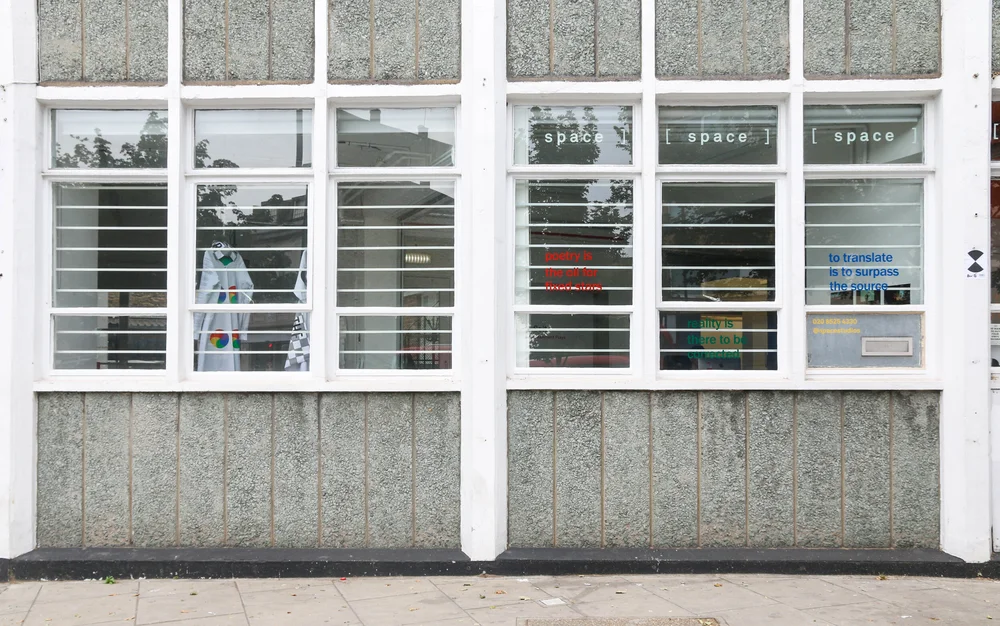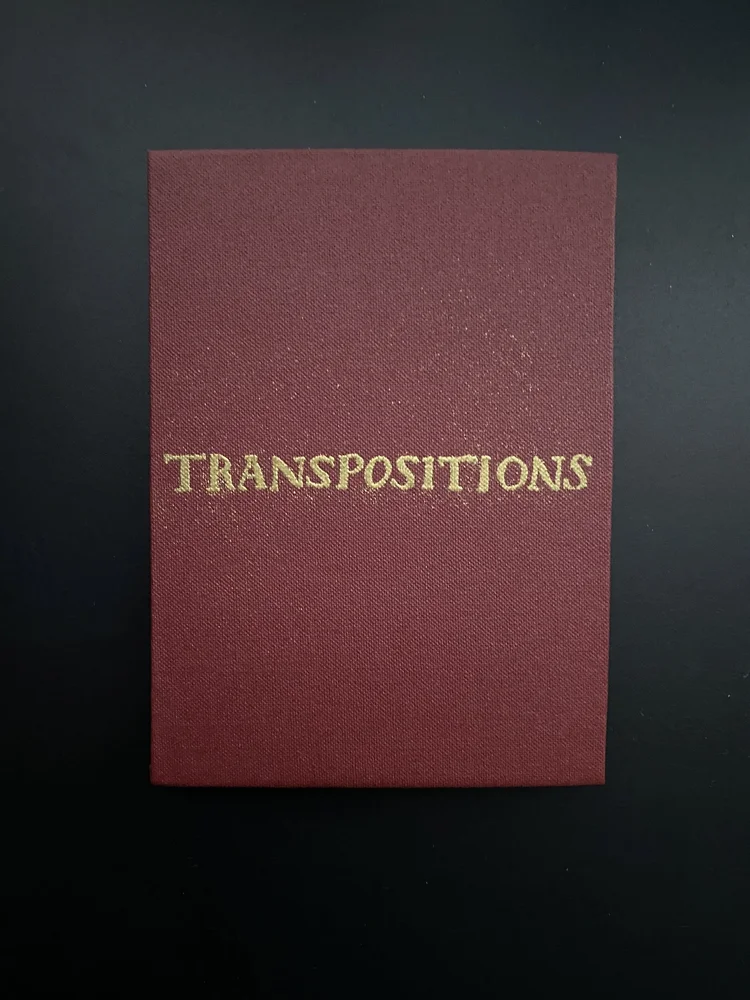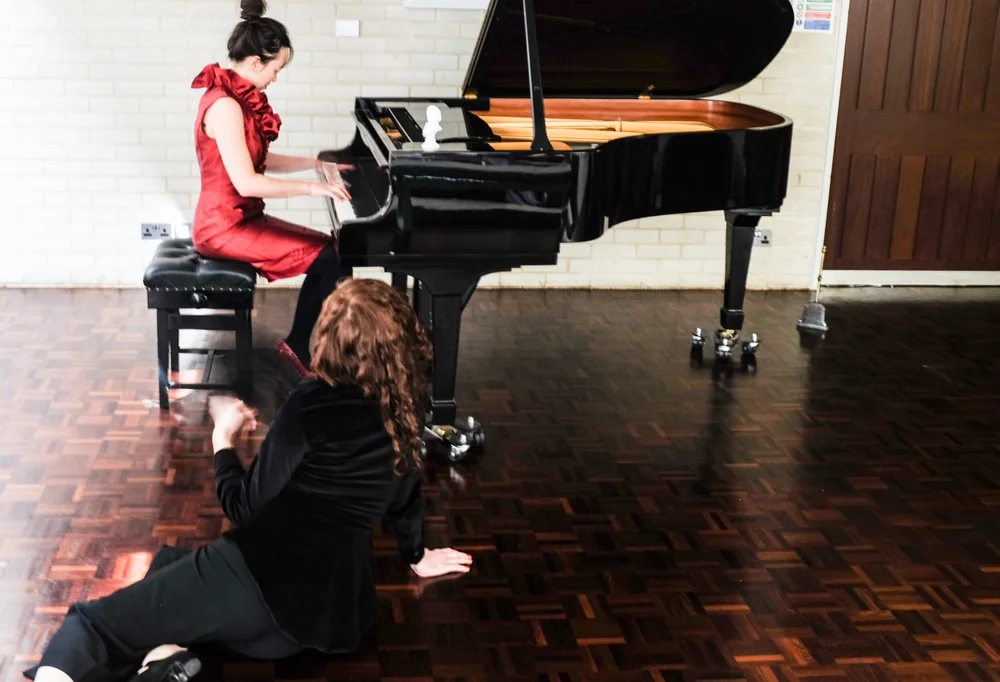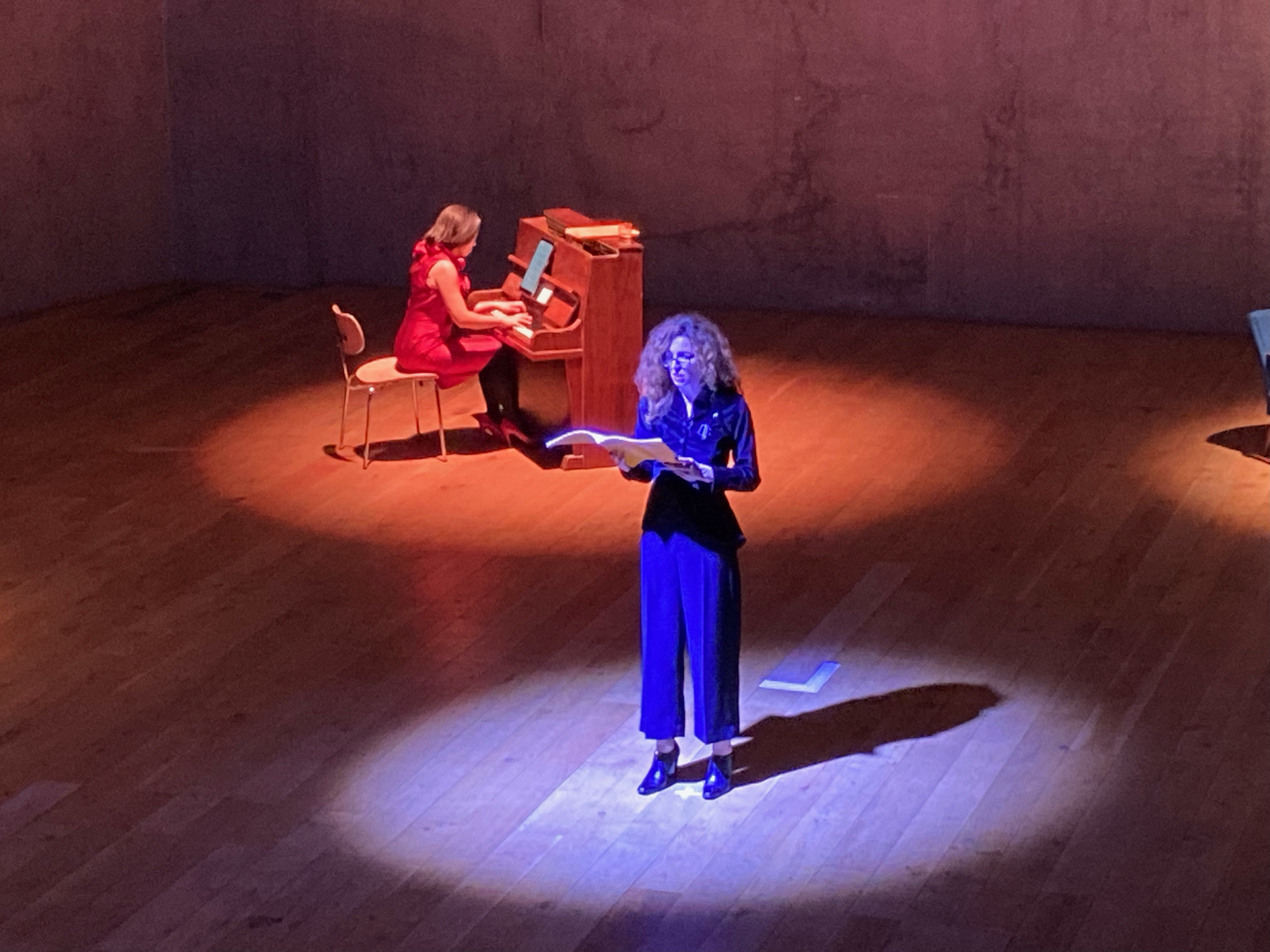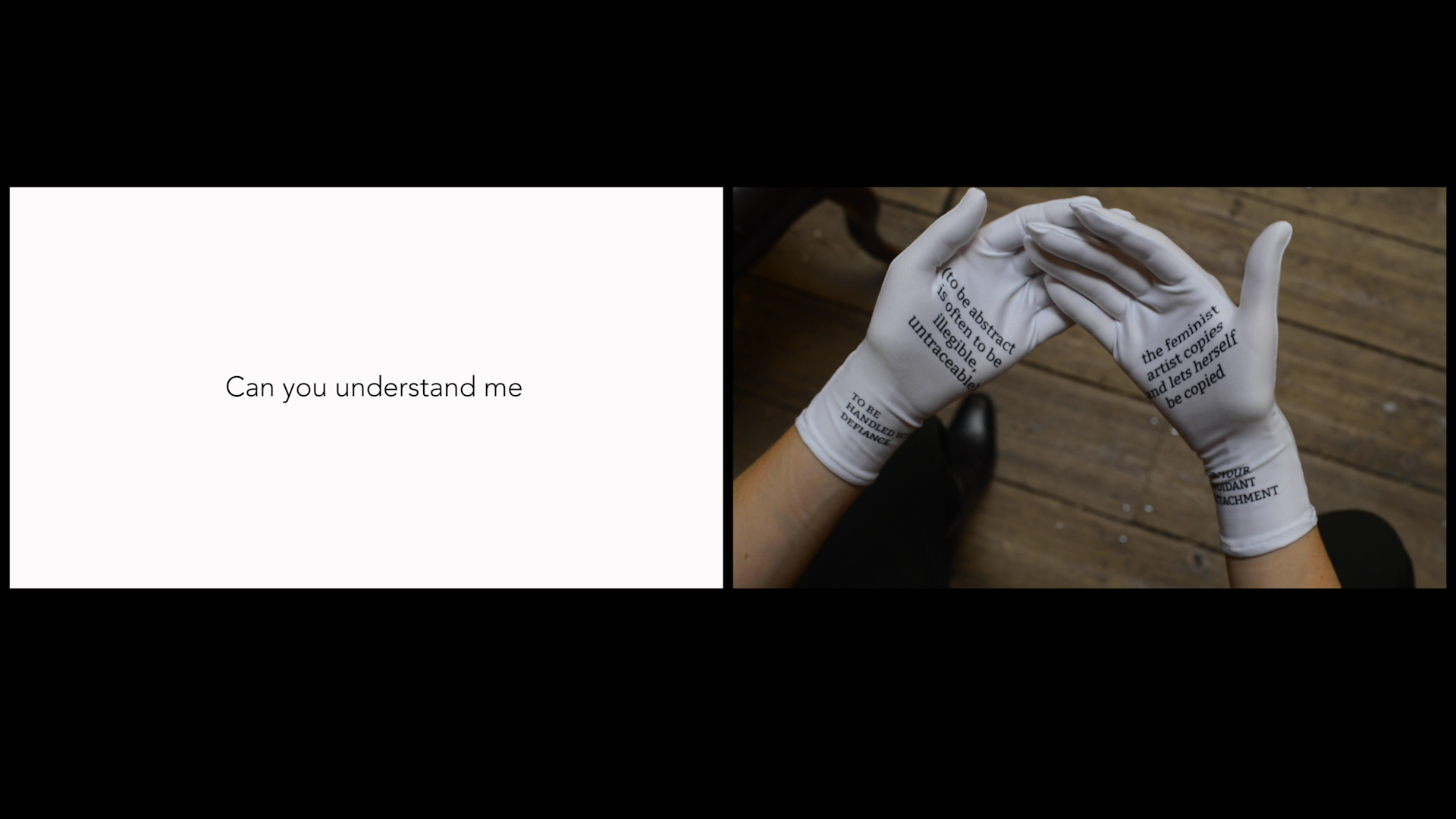Sophie Seita is an artist and researcher who works with language as a sensuous, sculptural, and sonic material, translated and moulded into live performances, performative objects, publications, sound pieces, videos, drawings, textiles, scores, and somatic workshops—using the voice and the body as sites of conceptual, material, and political enquiry.
Previous work has found a home at Café Oto, Queercircle, Mimosa House, UP Projects, Flat Time House, [ SPACE ], Art Night, Raven Row, Bold Tendencies, the Royal Academy, the Serpentine (all London), Kafkárna (Centre for Arts and Ecology, Prague), Ruta del Castor (Mexico City); BAAD!, Company Gallery, Issue Project, Printed Matter, Torn Page, and La MaMa Galleria (all NYC), Cluster Festival (Winnipeg, Canada), Taller Bloc (Santiago, Chile), the Arnolfini (Bristol), the Flemish Arts Centre De Brakke Grond (Amsterdam), JNU (New Delhi, India), Athens Experimental Lit and Performance Festival, Rupert (Vilnius), Nottingham Contemporary, Index (Stockholm), Grand Union (Birmingham), Kunsthalle Darmstadt, diffrakt (Berlin), The Women’s Art Collection, Kettle’s Yard (both Cambridge), Cité Internationale des Arts (Paris), and elsewhere.
Seita has received funding, awards, and fellowships from Arts Council England, the British Academy, the British Council, the Canada Council, Canada High Commission, Creative Scotland, Fonds DaKu (Performing Arts Fund, Germany), the Wellcome Collection and Cambridge Sociology Department, Literarisches Colloquium Berlin, Deutscher Übersetzungsfonds, a-n, Dover Prize at Darlington, Princeton University, Yale University, Cambridge University, PEN America, Hackney Council, Lambeth Council, among others.
Recent publications include: Lessons of Decal (87Press, 2023), a book of art writing, My Little Enlightenment Plays (Pamenar, 2020), a book of experimental performance texts, Provisional Avant-Gardes: Little Magazine Communities from Dada to Digital (Stanford University Press, 2019), a book of criticism, The Gracious Ones (Earthbound Press, 2020), a performance script, as well as art writing in Flesh Arranges Itself Differently (Roberts Institute of Art/Hunterian, 2022) and ON FIGURE/S (Ma Bibliothèque, 2021). Seita recently held residencies at Akademie der Künste (Berlin), Studio Voltaire (London), Britten Pears Arts (Snape Maltings), Freie Universität Berlin; and Brown University (Providence, Rhode Island).
With her long-term collaborator Naomi Woo, she co-runs The Hildegard von Bingen Society for Gardening Companions, which revives a feminist and queer gardening society believed to have been founded by the German mystic and musician Hildegard of Bingen. The collaboration takes the form of a community-driven and speculative art and research project focused on decolonising and queering gardening histories. So far, the society has presented work in the form of a solo exhibition; a zine called The Minutes; and various performances, rituals, workshops, and ‘meetings’.
Seita is a Lecturer in Fine Art (Studio Practice) and Director of Critical Studies (Fine Art Extension Degree) at Goldsmiths and also co-runs the interdisciplinary Sound/Text Seminar through Harvard’s Mahindra Center. Prior to Goldsmiths, Seita was an Assistant Professor at Boston University, a Research Fellow at Cambridge University, and a Visiting Scholar at Columbia University and New York University. Committed to collaboration, participation, and experimental non-hierarchal learning, Seita has also taught in both institutional and alternative educational settings, and was one of nine artists on the Constellations artist development programme run by UP Projects and Flat Time House; which supported artists interested in socially engaged practices and peer learning.
She lives in Hackney with her wife Laura and their Romanian rescue dog Cosmo.
artist statement
My practice is grounded in writing and performance but swerves voraciously into other mediums, such as sound, video, textiles, drawing, and installation. I always explore the machinations, possibilities, and politics of aesthetic form. I’m interested in a type of queer abstraction that is enriched by experience, but isn’t necessarily ‘about’ it in any straightforward fashion; instead it’s more of a commitment to a form of thinking, making, and relating, which I’d call a new grammar of relationality. This form signals non-linear, unpredictable, unfixed, and constantly shifting approaches to the body, knowledge, form, and desire.
Seeing that the core of my practice is language as material, I usually ask myself how text and the act of reading can be visualised and translated into textiles, movement, sound, space, costume, and performative or sculptural objects. How can, for example, the body become a publishing platform, and how can we be choreographed by language? How can I make language touchable, and how can I or an audience be touched by language? I often print or draw my research and process onto wearable textiles as an extension of my thinking out of or into language-as-material. So, many of my textile pieces become garment sculptures or ‘talking textiles’ or ‘listening fabrics’ when they’re activated through sound or performance (realised or just imagined).
Since language is often dominated by structures of knowledge that were formed by exclusionary and normative discourses or simply by habit, then these structures need to give way to other forms of sense making. This is where difficulty comes in. My work asks audiences to grapple with that difficulty, to delve into the in-between spaces, to question some habits. I’m curious about what can’t be communicated directly. How do we acknowledge ambiguity and multiplicity? How do we enjoy ‘not-getting-it’, or things that might sensorily or intellectually confuse us? I subscribe to what I’d call a sort of suspended aesthetics, which draws on Freud’s notion of ‘evenly suspended attention’; in other words, I invite audiences to allow their minds and bodies to hover and float around the work, without demanding immediate clarity or answers from it, or indeed from themselves!
I’m interested in the uncertain, provisional, fragmented, and often messy space of art practice as a site where we can resist the need to be clear, sure, and programmatic. Formally and tonally, I’m interested in juicy and tactile opacity, the whimsical, in polyrhythms, lush abstraction, sonic pleasure, and performative poise. My polyphonic investigations are also about listening. I’m dedicated to an attentive politics that recognises that aesthetic forms are never unburdened but enmeshed with our complex and complicit relations with(in) the world. My recent work therefore thinks about ecological dis/repair as a question of language, more-than-human relationships, and speculative archives. I’m interested in holding this complexity and complicity, dialectically. Performance, too, is an art of sustained (if distracted) attention, because it is durational; it teaches us something about the politics of attention: who pays attention, when, and how.
Aware that we never make work in a vacuum but within an ecosystem of other voices and practices, my work often layers references to other artworks, literary and theoretical texts, classical music and opera, across space and time. My thinking and making is rooted in queer and feminist commitments and histories, studied and performed in a non-linear, non-programmatic, and insistently playful fashion. These forms of contact or dialogue or entanglement can be recalcitrant, intimate, or resolutely ambivalent. I often wonder: what’s a sensual and embodied encounter with material that is conceptually rigorous and historically informed, but also aesthetically cohesive on its own terms?
Collaboration is deeply ingrained to how I work. It enables me to learn through difference—contextual, intergenerational, intersectional, geopolitical—and the responses which shift and realign in dialogue with other artists. I’m particularly interested in workshops—workshops are also the work.
contact
s.seita [at] gold.ac.uk

Remote residency at Khata-Maysternya (Ukraine), part of Songs of Serpents: Ecopoetic Zones, international residency programme
In my first meeting with Alona, I took a lot of notes, some of which said: close-ups, what is being overlooked? Quiet things in a loud time. Forms of call, being called to the environment. What is unexpected or surprising, noticing things, doing or seeing things at an oblique angle, slow travel, snail mail, extended duration/ inner landscapes…
I wondered what I could do given I couldn’t travel to the village of Babyn in Western Ukraine myself. What can travel, besides bodies—words, of course, so I did a mail art project writing to them ever day. Words travel, sounds, and scents—I sent drawings, a story, doodles, I did some research about Paraska Plytka-Horytsvitz, a potentially queer figure, and sent her some fictional letters; I also wrote various imagined sound walks, which I hope will be enacted by the team or future residents; I looked at maps, and noticed the concentric rings which signify mountains.
I wondered how I could write to or alongside a place, and specifically a place I do not know, have never visited—how could I animate the landscape or be animated by it in a sensitive, ethically attuned responsible way? What is my listening positionality in writing to, not about a place or landscape (I was here also thinking-with Dylan Robinson)….
Residency at Künstlerhäuser Worpswede (Germany), part of Songs of Serpents: Ecopoetic Zones, international residency programme
6pm, online. ‘Lesbian Fruit’, workshop for Queer Food programme, The Grammounce.
Lesbian Fruit will develop a juicy vocabulary for the many ways fruits have featured in the dyke-y imaginary, ranging from literary and art references like Gertrude Stein’s modernist poetry collection Tender Buttons (1914), to Zoe Leonard’s Strange Fruit (for David), 1992-1997, memorialising her friend David Wojnarowicz and other friends and colleagues lost to AIDS; to Cheryl Dunye’s landmark film The Watermelon Woman (1996).
The workshop will also include a practical culinary experiment and activation (in the form of a score) of a Hildegard von Bingen recipe. Bingen was a German mystic, musician, saint, and polymath, and believed to have been the founder of The Hildegard von Bingen Society for Gardening Companions, a queer feminist society revived and propagated by artists Sophie Seita and Naomi Woo in 2020 to carry on her legacy.
“Apple plum, carpet steak, seed clam, colored wine, calm seen, cold cream, best shake, potato, potato and no no gold work with pet, a green seen is called bake and change sweet is bready, a little piece a little piece please.”
Gertrude Stein, extract from 'Apples' in Tender Buttons
‘Scales of Breathing (Scores for Interspecies Collaboration)’, with Youngsook Choi, Jae-Lee Kim, Rike Scheffler, commissioned performance and installation, SeMA (Seoul Museum of Art), Seoul, Korea
Opening, Strings Attached, group show, Pipeline Gallery, London
Opening, group show, Akademie der Künste, Berlin

plastic lip slot machine responds to the ‘drawing-writing’ or graphic poetry of Belgian artist Sophie Podolski, on show at Goldsmiths CCA during summer 2025, and explores a shared interest in both artists’ practices of new forms of embodying text or ‘reading’ the illegible.
The performance emerges from Seita’s ongoing practice of ‘touching language’ through performance, performative objects, sound, scores, somatic workshops, and textiles, and an ongoing preoccupation with other forms of sense making and sensual encounter with materials. It occurs against the backdrop of Seita’s series of textile works titled and and and also, which depict experimental graphic scores for imagined voices and abstract bodies, and also feature other props for making language malleable, or out of—as Podolski says—‘some plastic material’.
shown at
Goldsmiths CCA, part of Deptford X
photos
Cat Spooner
HD video, 12:51 mins
A lecture performance or video essay on backs, the art of the back, which is also the art of obstacles, or the artist’s desire for the art of the obstacle. It also touches on forms of attention, the ethics of the back rather than the face, as well as a sensory, even sensual, approach to looking/listening/making.
Commissioned & published by Texte zur Kunst, Issue No. 136 / December 2024 "Lecture"
An accompanying questionnaire was published in the print issue and online and can be read here.
The video lecture can be watched here.
shown at
silent green, Berlin, Nov 2024
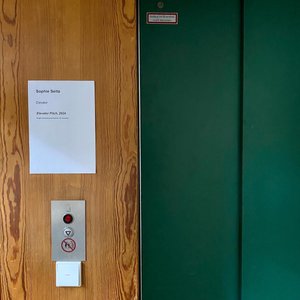
Single-channel sound piece, 57 seconds
In her site-specific sound installation, Elevator Pitch, Sophie Seita’s voice greets visitors in the lift with a series of pitch exercises, as a form of attunement. A lift, like a larynx, is a transitional space, a passage for air and movement.
shown at
Akademie der Künste, Berlin, September 2024

Klangfigur I-VII — silk screen on mercerised cotton, embroidery; 80cm x 254cm
performance garment — silk screen on cotton
audio description — digital sound, 22:31 minutes
artist statement — digital sound, 7:20 minutes
and and and also is a series of textile pieces that depict experimental graphic scores for imaginary queer voices and bodies, accompanied by two sound pieces.
Graphic scores are alternative forms of notation for sound and performance. They move away from the traditional notation of the five-lined musical stave in favour of more expressive, unconventional, and often abstract notations, at the intersection of art, sound, performance, and movement. Given their experimental non-normative nature, the scores remain unfixed, in process, and open to interpretation by and for different bodies and voices.
a body might
tilt
cavort
peal
In Seita’s textile installation, the scores capture so-called Klangfiguren, German for ‘sonic bodies’ or ‘figures of sound’, which is both a musical term and a literary stylistic device, which brings the senses of hearing and seeing closely together. These Klangfiguren are conceptual sounds or allegorical bodies. An allegory is a form of ‘veiled language’, an image or story that captures new concepts but never explicitly. An allegory can also be a material object and visual representation that makes an idea or feeling visible and tangible. Seita’s drawn and printed allegorical sound bodies, then, represent a queerness we do not yet know. In the origin of the word allegory also lies a suggestion for how it may be used. It’s a Latin word that originates in the Greek and combines allos ‘other’ or ‘different’ and agoreuo ‘to speak in assembly’. In performance, these scores find their other-speaking in a new assembly, in a different (queer) community.
Scores, for the artist, allow reflection on artistic process, on bodies, and (il)legibility. Listening, sound, movement, and performance in this project are not limited to normative understandings of how we can or should use our bodies. The scores can be interpreted by different bodies, different voices, and don’t assume a primary language, form of expression, or range of ability. The work is informed by a drawing and sound workshop with queer young people hosted by Curious Arts (Newcastle) and by The Lichtenberger® Method in Applied Vocal Physiology, the singing method the artist learned in Germany several years ago, and the work includes prompts inspired by the method’s playful and poetic somatic pedagogy.
The textile works are accompanied by the artist’s own creative audio description (developed in dialogue with an access consultant) as well as a short performative artist statement as a sound piece that imagines and translates what these scores could sound like and what kind of queer relations or desires they intimately perform.
Read more about the process of making the wotrk and some ideas behind it in this working diary, commissioned by Akademie der Künste.
shown at
Darlington Library’s Crown Street Gallery, solo show, August 2024, photos: Rachel Deakin
Akademie der Künste, Berlin, Open Studios, September 2024, photos: Stefanie Walk, Jo @aurali_sm
Sound pieces included in Free City, a group show curated by Mayer Pavilion, Stadtwerkstatt Kreuzberg, Berlin (2024)
sound
Recording and mixing by Eve Singleton, 2024
access consultant
Richard Boggie
funding
Creative Darlington, Darlington for Culture, 2024
Werner Düttmann Fellowship, Akademie der Künste, Berlin, 2023-2024
Research & Development Grant, NEUSTART KULTUR im Programm #TakeHeart, Fonds Darstellende Künste e.V., 2023

textile piece — digital pigment ink print on 100% cotton gauze in two pieces, top: 136x133cm in 112gsm; and bottom: 99x43cm in 125gsm
These Devices Became Law is a new performance and textile work by Sophie Seita that responds to two historical utopias (Thomas More’s Utopia and Madeleine de Scudéry’s Clélie), their promises, flaws, and fault lines. Seita’s performance costume, which overlays reproductions of historical maps with her own ink and soft pastel drawings, is printed onto double gauze, a fabric chosen specifically for its etymological and historical link to Gaza, Palestine. She recalls queer performance theorist Jose Muñoz who defined utopia as ‘not prescriptive; […] a horizon of possibility, not a fixed schema’, but also importantly as ‘a stage’. In the process, Seita’s work interrogates and imagines deconstructed geographies, violent maps, tender maps, queer maps, unnavigable maps, indecipherable maps—the gauze that dresses a wound.
Commissioned by Akademie der Künste for ‘New Forgotten Utopias’, the work is situated within a larger project on queer performance scores that uses artistic research, experimental drawing, and somatic workshops, developed in dialogue with Creative Darlington, Darlington Library, Curious Arts, and in the context of the Werner Düttmann Fellowship at Akademie der Künste, Berlin.
The piece was also made quite explicitly against the raison d’etat of the German state and its repercussions in the form of restrictions on artistic freedom of expression, cancellations, and the repression of Palestinian solidarity.
performances
The New Present Tense, FAC (Feminist Autonomous Centre), Athens, curated by Dimitra Ioannou, Nov 2024
Middlesbrough Arts Week, performance at Pineapple Black, curated by The Auxiliary, Sep 2024
Open Studios, Akademie der Künste, with music by Eve Singleton, September 2024
Akademie der Künste, Berlin, May 2024
funding
Werner Düttmann Fellowship, Akademie der Künste, Berlin
photos
garment sculptures, in studio/installation — Laura Cobb, 2024
performance — Berlin Stefanie Walk and Jo @aurali_sm, 2024
performance — Middlesbrough Art Week) Rachel Deakin

Conceived and embodied collaboratively by Jehan Roberson, Naomi Woo, Victoria Perrie, and Sophie Seita
Tributaries is a ritual about water, about time, about absence, about queer ancestors who have been lost and who we commit to remember. It is a ritual of blessing and complicity, of coming together, of mixing. We invite you to remember, reflect, and repeat this ritual, always concluding in tight embrace.
The ritual was devised for Sembrando Humedad (Sowing Moisture), a five day learning gathering in the ancient wetlands of Xochimilco, Mexico City, organised by Ruta del Castor and Carolina Caycedo, in collaboration with artists, activists, farmers, community members, collectives, organisations, educational institutions, and students, to collectively reflect on our relationship with water as a binding body that weaves together cultures and ecosystems.
Sembrando Humedad formed part of mare-a-ndo, Ruta’s wider curatorial project that had various iterations related to water and concluded with our encounter in Xochimilco.
一 Who is your chosen queer ancestor/spirit? Why did you bring them into this space?
一 What do you need from them/the water?
一 What do they need from you?
一 What types of kinships and intimacies emerge from these ancestors coming together?
The group develops and records laws for this mixed water, asking themselves: How must we treat this water? What do we owe the water?
一 How can we interact with it?一 What will we do with it next?
一 What are the repercussions of the maltreatment of the water?
一 What sounds must the water make?
一 How long must the water be held before disposing of it?
一 Who is responsible for upholding these laws?
Use your saliva to wet the edge of the vial. Blow into and across the vial, animating the ancestors’ voices together, and sending their collective energies out into the world.
events / performances / offerings
Sembrando Humedad, Xochimilco, Mexico City (1-5 April, 2024)
London, Winnipeg, NYC (2024/2025—upcoming, more details tbc)
photos
Courtesy of Ruta del Castor and Eduardo Velasco Vasquez and Andrés Jurado
funding
International Science Partnerships (ISPF) Institutional Support Grant (ODA)
Canada Council for the Arts, Explore and Create: Concept to Realization (2024)

Working with video, textile, autofiction, and various installation processes, Sophie Seita’s and Naomi Woo’s exhibition pulls out and reroots the speculative potential of archives and queer history. Developed in conversation with The Hildegard von Bingen Society for Gardening Companions, a queer-feminist collective originally founded by the German mediaeval mystic and musician Hildegard von Bingen in the 12th century and ‘propagated’ by the artists in 2020—the exhibition centres on a queer gardening talk show, bingenTV, supposedly shot in 1987 and never aired, until now. Playful and flirty, this genre-bending talk show features a cast of queer characters real and fictional, past and present, in a whirlwind jaunt through space and time.
For the duration of the exhibition, the space was activated through readings, workshops, and performances, by Youngsook Choi, Taey Iohe, Sophie Seita, Naomi Woo, Ashley Au, and Sister Steve of Ophelia Drowning (Kell w Farshéa).
bingenTV is conceived by artists Naomi Woo and Sophie Seita, in conversation with The Hildegard von Bingen Society for Gardening Companions, produced by Queer Art Projects and funded by Canada Council for the Arts, Arts Council England, and the Art Department at Goldsmiths, University of London.
Press release (including work list and credits)
shown at
Mimosa House, 27 Oct 2023-8 Dec 2023, PV 26 October.
Cluster Festival, Media Pool, Winnipeg, 5 June – 5 July 2025
photos
preview — Natalia Janula
stills of bingenTV, the film, 2023 — Katarzyna Perlak, Sophie Seita, Jack Barraclough.
cast in the photographs — Alice Morgan-Richards, Steffi Walker, Milla Harding, Ishmael Kirby, Jacqui Bardelang, Naomi Woo
install shots — Laura Cobb
funding
2023 ECRF Grant, Goldsmiths, University of London
2023 Arts Council England, Project Grant
2022-2023 Canada Council for the Arts, Explore and Create: Concept to Realization
2021-22 Canada Council for the Arts, Explore and Create: Research and Creation
2021 ’New Conversations’ grant, from the British Council, Canada Council for the Arts, Farnham Maltings, and The High Commission of Canada in the UK
reviews
Elephant Magazine (Nov 2023)
Now Nancy/Soho Radio (Nov 2023)

vol. 1
Spring 2022
The Minutes is an artist book in the guise of a gardening newsletter (or an allotment bulletin in the guise of a conceptual art project) that gathers some recent work by members of the Hildegard von Bingen Society. The publication is designed as a garden, with its spatial and imaginary nooks and crannies, its tools and sheds, its cycle of growth, decay, and dormancy.
editor
Sophie Seita
designer
Yael Ort-Dinoor
contributors
Lucía Hinojosa Gaxiola & Lee Ann Brown
Jenny Chamarette
Taey Iohe
J R Carpenter
Taraneh Mosadegh
Tuna Erdem & Seda Ergul (Istanbul Queer Art Collective) with Sophie Seita
Ghazal Mosadeq
Youngsook Choi
Erin Robinsong
Sophie Seita & Naomi Woo
Yael Ort-Dinoor
Printer
Newspaper Club in Glasgow
vol. 2
Spring 2023
The Minutes is the society’s irregular almanac, a shared creative space in print-form that connects people across time and space no matter what their practice is. It features poetry, artwork, conversation, performance documentation, research, process notes, and rituals, and thinks about stretchy time, forms of embodiment, the scale of intimacy, the environment beyond the ‘natural’, and gardening as teaching, teaching as gardening.
editor
Sophie Seita
designer
Yael Ort-Dinoor
contributors
Lucía Hinojosa Gaxiola
lee rae walsh
Youngsook Choi
Ruby Reding
Kaya Erdinc
JR Carpenter
mattie o’callaghan
Sawako Nakayasu
Vanessa Zappi
Kate Clayton & Sophie Seita
Adam Moore
Yael Ort-Dinoor
Printer
Newspaper Club in Glasgow
Copies are available for sale atPrinted Matter (NYC) and through our website. If you’re interested in purchasing a copy, you can do so via our paypal (account details are our email address). Please note the difference in purchase options for individuals ($20/£15/17EUR + $5/£3/4EUR shipping) and institutions ($60/£50 + $5/£3 shipping). Any questions or feedback, please email us at hildegardsgardeningcompanions[at]gmail.com


Published by the 87Press, Dec 2023. Available to order here.
Lessons of Decal is a meditation on reading, listening, play, not-planning, touch, texture, queer abstraction, lush abstraction, a poetics of porosity or percolation, cloudiness, desire, and confusion. Laced with lyricism and playfulness, this essay collection views Form as its side-kick, its beloved. A decal is a copy, a transfer of forms and knowledge, something that sticks and leaves a mark.
You can read an interview about the work, conducted by Kashif Sharma-Patel here.
How does the bronze wire speak back to the writer who tenders it? What is the role of autobiography in a teaching practice that develops questions through touch, and the theory of that touch? How can vulnerability, in writing, be the place that writing comes from, actually? Sophie Seita's essays are staged at the boundary of body and text, commitment and memory. Lessons of Decal invites an idea of the book as a set of gestures and possibilities, invoking (on every page) the experimental and queer ancestors who "speak nearby."
— Bhanu Kapil
A love-letter to artistic research, Seita's writing celebrates the desire, disorientation, and discovery to be found in feminist practices of reading. A potent reminder of the generative passion that we can only wish motivated all critical inquiry.
— Gordon Hall
Reading Sophie Seita’s invigorating and instructive essay collection, Lessons of Decal, I returned to key questions about and practices of reading and artmaking, which Seita explores from numerous angles: queer, feminist, historicist, bibliophilic, political, and personal ones, to name but a few. Here the figure of the decal is but one of the many productive metaphors Seita explores. Employing playful, innovative prose forms that took me beyond the page into the space of performance—many of these essays were originally presented live and in print have lost none of their brio--Seita drafts an original roadmap for thinking about past art and making new art today.
— John Keene

series of drawings — charcoal and graphite on 300gsm cotton watercolour paper (22.9 x 30.5cm) and Khadi rough cotton rag paper, 210 gsm, (21 x 25cm)
Swimming in the Muddy Waters of Language (A Score for Verbs) is a series of drawings and a performative lecture that draws out language and looks at this act of drawing out as an engagement with muddiness. Such a type of writing is sloppy, damp, cloudy, messy. It rejects purity and cleanliness in favour of the indirect, the wobbly, it revels in its own confusion and vagueness. As a proposition. A letter to the future. A form of reading. Sometimes muddiness occurs when sediments are stirred up; when the water experiences disturbance. Mud is a witness to disturbance. It gives shape to our ideas.We can thrive in it. Or we might get stuck. And then maybe this wrestling with viscosity, with mud’s nutrient-rich, impressionable body which holds other bodies, asks us: what do we do with this? What can this language of doing or not-doing accomplish?
The lecture began as an address to my students‚ students whom I once advised to ‘swim in the muddy waters’—in other words, to reject comfort and clarity in favour of something a little more uncertain and exciting. It was an explanation of my pedagogical method and a proposal for their artistic practice. Later, during a strike period, I wrote the same students a letter that was also a score. An invitation.
performances
Royal College of Art, for ‘Mud: The Urgency of the Arts’, alongside Ali Cherri and Dr Shehnaz Suterwalla (2023)
Cornell University, Humanities Scholars Program (2023)
What are Words Worth? group exhibition and events programme, Gallery North, Newcastle, (2024)
publication
What Happens, Buffalo, NY, 2025


sound installation (work in progress), 24:06 minutes
The Gracious Ones is a philosophical ballet for three voices on metaphorical treadmills. The sound piece forms part of a larger body of work, which will consist of three screen-printed fabric sculptures that ‘speak’ and ‘sing’ at an imaginary banquet. Loosely based on Plato’s Symposium, where notable philosophers participate in a contest of spontaneous speeches, Sophie Seita’s piece adds a more personal and queer spin. Her three characters debate and praise love in cheeky speeches, melancholy songs, and obsessive monologues, stealing liberally from correspondence, literary sources, and each other. The collaged and procedural sound piece creates a polyphonic chorus in action that touches on questions around ambition, beauty, desire, and disappointment. Chatting away, repeating themselves, talking over each other, the figures also muse on the process of making art and always return to love in all its glorious, ridiculous, and embarrassing too-muchness or sometimes too-littleness. The fictional voices run from and towards themselves in a circuit of misreading and mishearing, tender vulnerability and feisty nonchalance. Who gets to speak and who will care to listen?
concept, text, artistic direction, and voice — Sophie Seita
audio production and mixing — Rupert Clervaux
exhibition
Freie Universität Berlin (2022)
Free City, a group show curated by Mayer Pavilion, Stadtwerkstatt Kreuzberg, Berlin (2024)
events/listening sessions
UP Projects (2022)
IKLECTIK (2023)
FormaHQ (2023)
supported by
County Durham Community Foundation’s Dover Prize Fund (2021)
Dorothea Schlegel Artist in Residency Programme, Berlin (2022)
Research Support Award, Goldsmiths, University of London (2024)
Earthbound Poetry Series: Sophie Seita (Vol. 1, No. 47). Available here.
Published 23 November 2020
text — from The Gracious Ones, by Sophie Seita [extract from performance text]
cover — Mountains in the Warehouse, by Gayle Chong Kwan. Digital Photographic Printed Postcard (2012)
Printed in Aqua, Fluoro Pink, Yellow, and Black riso inks, on FSC certified Munken Pure 170gsm acid free paper. 8pp. Edition of fifty-two numbered copies.

performance for camera and C-Type Fuji Matt prints on archival paper
Fingers are for Feeling is a performance for camera inspired by and in close proximity to the Schaum Keyboard Touch Finder, a vintage learning aid used to teach aspiring pianists to sight-read without looking at their hands. This performance emerges from a long-standing interest in paper costumes and keeping text close to the heart and hands.
‘Note: The Schaum Keyboard Touch Finder is to be used until the student is able to find the keys without looking at his hands on the keyboard and when the habit of keeping eyes on the music has been established. This will require at least 4 to 8 weeks of constant use.’

screen-print on cotton with text in two colours (orange, blue), dimensions: 3.45m x 1.45m, oak rod
withwithwith is a textile piece originally made for live performance. The screen-printed text is an erasure of Sophie Seita’s piece ‘Reading the Rock’, leaving behind only the prepositions. The prepositions trace the text’s preoccupation with making seemingly incommunicable feelings more tangible. The blue text was made using puff binder which creates a raised surface texture after it reacts with heat in the curing process. So when you touch the text it’s as if the words move a little bit closer to you, creating a different kind of space or relation with or through you. Prepositions are all about contact and direction. They determine how we move in space; how we view ourselves in relation to what surrounds us; what or who touches us and what or whom we touch or move alongside in return.
(The performance costume is also screen-printed, on the ‘wrong side’ of some leftover jersey fabric.)
shown at
Molto Molto, Hove, 17 September 2022
Reference Point, London, December 2022, part of qap.digital launch
Ugly Duck, ‘Pretty Doomed 2023’, curated Queer Art Projects & Ugly Duck, Oct 2023
photos
analogue — lee rae walsh (2022)
install — Marco Berardi and Baiba Sprance (2023) for 'Pretty Doomed 2023' by Queer Art Projects & Ugly Duck
beach performance — Sophie Seita (2022)

In response to her installation My Contact Aureoles, Sophie Seita’s lecture performance Reading the Rock explores poetic and geophilosophical questions about time, embedded histories, and queer intimacy. It bends into and around different body-and rock-formations—responding to the metamorphic, igneous, and sedimentary rocks in the Big Bend National Park on the border between West Texas and Mexico. The piece harnesses other materials and voices to tease out the complex from the simple and vice versa, all pivoting around some questions that animate her work in the show: How can a work hold a moment, translate it, make it tangible and yet remain ultimately unknowable? Or more simply: How can I experience this enough?
shown at
Hoxton253, London, Feb 2022. Photographs: Mirko Boffelli Photography (2022). Performed inside the installation My Contact Aureoles.
molto molto, Brighton, Sep 2022. Photographs: lee rae walsh (2022). Performed against the backdrop of a new textile work, withwithwith.
a.p./Callie’s, Berlin, Nov 2023. Photographs: Lea Hopp (2023)
McCormack Family Theater, Providence, Rhode Island (2023), photo courtesy of the artist.
costume
Two-colour screen-printed photograph on white French terry jersey fabric (2022). Photographs: Laura Cobb (2022)
funding
‘Hello again, Hackney’ Grant, Hackney Council
Eaton Fund
Deutsche Forschungsgemeinschaft (DFG, German Research Foundation) under Germany’s Excellence Strategy in the context of the Cluster of Excellence ‘Temporal Communities’ – EXC 2020 – Project ID 390608380
Artist in Residency Programme, Literary Arts, Brown University

Birch ply panels (104x69cm), gesso, graphite, and drafting film sheets, projection, sound (6:33). Sound recorded and mixed by Rupert Clerveaux. Photographs by Laura Cobb.
full title: after the cooling, the igneous, which sets, has the potential to ignite, my contact aureoles
My Contact Aureoles began as a series of performance photographs taken by the artist’s partner in a dried-up canyon in the Big Bend National Park in Texas near the Mexican border in March 2020. These images became an invitation for a text written in response, starting a dialogue through interwoven materiality. Thrown onto the variable solidity of wooden panels and curtains of drafting sheets, the photographs remain—just like the memory and intimacy of what’s depicted—only projection, only light. The text, both recorded and inscribed in graphite onto the panels, reads the images and they in turn document a process of reading the rock. The work deals with the knottiness of articulation and loving address, the play between abstraction and autobiography, and the difficulty of capturing feelings, their reverberations and entanglements. Wavering between ephemerality and commitment, words become surety and (in)tangible promise. Other themes that surface and stick are curiosity and mysticism, the process of bringing the complex into the simple or vice versa. While the photographic series remains ephemeral and refuses to become an object, language itself does become the material around which everything spins centrifugally. Each element of the piece represents an act of material translation, as radiant contact.
A conversation between the two artists and the curator Zsuzsa Benke is available here.
The opening lecture performance developed into a separate piece, more here.
shown at
There’s no way I can know it, the object, or the body, two-person show, Hoxton253, London, 2022.
photos
Mirko Boffelli Photography (2022)
funding
’Hello again, Hackney’ Grant, Hackney Council;
Eaton Fund

HD video, 14:41 minutes
Cloudiness is a video essay by Sophie Seita that plays with the materiality and tactility of translation within and beyond language. Translation as movement. As visual-haptic echo chamber. Is translation always the retracing of shapes already carved, of thoughts already voiced, now tasked with a different sort of materialisation on a variable scale of proximity? Experimental translations, in particular, make their scaffolding visible. To intentionally upset the truism of translational invisibility, the scaffold visualises a material process. This making-visible does not aim for a transparency of meaning. Instead, experimental translations side with a certain cloudiness...
Originally commissioned by Anna Luhn & Lena Hintze, for THE GAME(S) OF TRANSLATION, in collaboration with LCB (Literarisches Colloquium Berlin) & TOLEDO, & the Cluster of Excellence “Temporal Communities. Doing Literature in a Global Perspective” at Freie Universität Berlin. Captions by Robert Steffani.







shown at
Crossing Borders, group show, curated by Hannah Imhoff, Millbank, London. Install photos: Monika Drabot; preview photo: Vera Kern
There’s no way I can know it, the object, or the body, two-person show, Hoxton253, London, 2022. Install shot: Mirko Boffelli. Stills taken from video by the artist.
screening
Bard College (2022)
Newham Word Fest (2022)
87Press/Cafe Oto (2023)

Performed with Naomi Woo
be gone
leave no trace
be lost to view
pass out of sight
Reveille is a multi-media performance piece and homage to Korean-American filmmaker and artist Theresa Hak Kyung Cha (1951-1982). In this durational performance, Sophie Seita and Naomi Woo recreate Cha’s poetic piece, Reveille Dans La Brume (1977) and from Vampyr, using spoken dialogue, projectors, tape recorders, choreography, lights, shadows, and analogue sound.
Cha’s original description of Reveille dans la Brûme reads: ‘The title itself, “Awakened in the Mist” alludes to “elsewhere”; source, or multi-gradations, levels in what seems singular in our perception, to articulate, to speculate upon dimensions made visible to us through suggestion, through induction, attempting to find a collective key, associations, that would result in a kind of transformation in the audience, as well as the performer.’
Our performance takes this description as a guiding light in re-presenting Cha’s work. ‘Awakened in the mist’ of Cha’s elsewhere, we transmit her original work in a new way. Going beyond pure re-enactment, we allow ourselves to ‘speculate upon dimensions made visible to us through suggestion, through induction’.
This form of engagement with the past—which includes re-creating the original transparent slides while adding our own materials—allows us to create an environment for new, embodied, and altered forms of knowing. Our added materials include small pull lights which are both sources of light but also musical instruments, enabling the ‘collective key’ Cha describes. We are inspired by Elizabeth Freeman’s concept of ‘temporal drag’—a capacity for queer, non-linear engagement with time and the past. We quite literally ‘drag’ Cha’s text, slides, and our other props across the performance floor, in order to choreograph and transmit alternative queer modes of history and thought. The slides and simple props evoke the history of mail art (which Cha used herself), street works, and early performance art, but also emphasise the collective nature of performance and recreation. In sharing this work—and our re-made props—with Cha, each other, and audiences, our objects become extensions of feminist kinship, then and now.
lumiere ombre
Part of an ongoing project in which Sophie and Naomi re-stage, re-imagine, or performatively translate work by neglected female artists, musicians, writers, and philosophers, whether their work was intended for performance or not.
performances
Cafe Oto, London (2022)
Kettle’s Yard, Cambridge (2018)
Yurt Space, London (2018)
De Brakke Grond, Amsterdam (2019)

My Enlightenment Plays is a multimedia project centred around three experimental theatre pieces: 1. Don Carlos, or, Royal Jelly; 2. Les Bijoux Indiscrets, or, Paper Tigers; 3. Emilia Galotti’s Colouring Book of Feelings — all of which present imaginary tête-a-têtes with Enlightenment thinkers, writers, and scientists.
A solo exhibition at [SPACE] Mare Street (June-July 2019) showed a selection of videos, sound pieces, texts, performance props and costumes from the last three years of this multidisciplinary project - together in one installation for the first time—as a layered world that allowed for the work(s) to be seen in a new light, as traces of past events, future scores and performing objects. Each element in a performance visualises, embodies or translates the text into another medium — which is itself a queer-feminist and oblique translation of Enlightenment texts and ideas. For this, Sophie Seita invited artists who work in other media to create sculptures, projections, music, and clothes that functioned as her props, costumes, and sets. (See individual pages for each play for more detailed descriptions and names of all collaborators).
The project as a whole asks how a dialogue with Enlightenment figures can positively mobilise aspects of that era politically and aesthetically (tolerance, hospitality, a diverse utopia), while critiquing others (progress, fraternity, imperialism). Highlighting the Enlightenment’s relevance to our contemporary artistic and political preoccupation with ‘values’ and ‘truth’, the exhibition tests knowledge, universality, rationality, certain forms of empiricism, individuality and progress, asking: for what and whom? How and how far? In a time of ‘alternative facts’, how can we salvage the speculative in creative work and follow its utopian promise towards imaginative ways of producing and distributing knowledge? What would a new feminist, queer, and welcoming ‘Republic of Letters’ look like today?
My Little Enlightenment Plays blends this reworking of historical material (astronomy, astrology, Mesmer’s energy healing, salon culture), with contemporary queer affect theory, the (pseudo-)psychology of colour-symbolism and Bauhaus-style abstract costumes and experimental dance. Translating and challenging the Enlightenment’s opposition of sentiment and rationality, the exhibition harnesses the experimental spirit of things that don’t quite work and are thus exactly aligned or fizzingly oblique, toying with current assumptions about seriousness, identity, obscurity, form and fun, and showing that deliberate artifice can be an affective space and vivid presence in which the audience can dwell and be held.
My Little Enlightenment Plays
Pamenar Press, 2020
My Little Enlightenment Plays compiles the three plays at the heart of this sprawling, multi-year performance project: Don Carlos, or, Royal Jelly; Les Bijoux Indiscrets, or, Paper Tigers; and Emilia Galotti’s Colouring Book of Feelings.
Many thanks to the publisher Ghazal Mosadeq and to the designer Hamed Jaberha.
Pamenar Press is an independent, cross-cultural, multilingual, experimental publisher, based in the UK, Canada, and Iran.
Purchase here.
The book is also available from Houseman's in London, Good Press in Glasgow, The Red-Wheelbarrow in Paris, Hopscotch in Berlin, and Flying Books in Toronto.
My Little Enlightenment
Other Forms (Summer/Fall 2019)
My Little Enlightenment is a lecture performance on 18th-century philosophers in dressing gowns, female salonnieres, paper utopias, obscurity, the chromatic buzz of what’s knowable, Jean Cocteau’s theatre-poetry, Gertrude Stein’s giddiness, star-gazing, poetry and bugs under the microscope, alternative encyclopaedias, ornament, cartouches and other fricative frames.
First presented inside an absurd salon full of paper lampshades, coloured lightbulbs, projections, and miniature theatre sets (designed Yates Norton), this book is both a document and score, but also a poetic and visual text that works on and with the page.
Designed by jack henrie fisher
Purchase here.
shown at
[ SPACE ] Mare Street, London (2019)
photos
Laura Cobb (2019)
publications
My Little Enlightenment Plays (Pamenar Press, 2020)
My Little Enlightenment: A Lecture Performance (Other Forms, 2019)
funding
Arts and Humanities Impact Fund (2019)
Public Engagement Starter Grant, University of Cambridge (2017-2018)
Vice-Chancellor’s Public Engagement Award, University of Cambridge (2018)
Art Night 2018
Lambeth City Council
Cambridge Humanities Research Grant (2018)
Research Fund, Queens’ College (2018)
Judith E. Wilson Grant (2017)
Cambridge Humanities Research Grant (2017)

Part of My Little Enlightenment Plays
Don Carlos, or, Royal Jelly is incestuously and whimsically enamoured with Schiller’s and Verdi’s Don Carlos. It queers some of the main characters and presents the court as a (non-re-)productive beehive, but with a darker subtext (filicide, the terror of the Inquisitor), and draws parallels to avant-garde promises of revolutionary upheaval.
Don Carlos, or, Royal Jelly is part of My Little Enlightenment Plays, a series of texts, performances, and installations.
performances
Company Gallery, New York (2016) with Corina Copp, Josef Kaplan, Lanny Jordan Jackson, Luke McMullan, Emma Attwood, Jocelyn Spaar, Holly Melgard, Yates Norton, with props by Anna Moser
Arnolfini, Bristol (2017), with live electronic sound by Rhodri Karim, photos (above) by Lua Ribeira
SALON London (2018)
[SPACE], London (2019), with live electronic sound by Rhodri Karim
video credits
Written, directed, and performed by Sophie Seita (2019)
Filming: Katarzyna Perlak
Edit: Katarzyna Perlak and Sophie Seita
Music: Rhodri Karim
Voice-over dialogue: Emma Attwood and Sophie Seita
Sound mastering: Rupert Clervaux
exhibition (video)
Heong Gallery, Cambridge, part of We Are Here group show (2020)
sound pieces
Pale Face and Happy Face (2017)
A sound piece, attached to two masks, to be listened to with headphones
Text, concept: Sophie Seita, with music by Rhodri Karim
Voices: Sophie Seita and Emma Attwood
Pale Face and Happy Face masks originally made by Anna Moser for a performance of Sophie Seita’s Don Carlos, or, Royal Jelly, Company Gallery, New York, 2016
Duration: 2:48 min
Red-Baiting (2017)
A sound piece, with a headdress, to be listened to with headphones
Text, concept: Sophie Seita, with music by Rhodri Karim
Voices: Sophie Seita and Emma Attwood
Headpiece originally made by Anna Moser for a performance of Sophie Seita’s Don Carlos, or, Royal Jelly, Company Gallery, New York, 2016
Duration: 2:19 min

Part of My Little Enlightenment Plays
A whimsical and magical world of female friendship and immodesty, where jewels sing and books talk and geometry descends in octagons and hexagrams, in crushing cascades and nervous nebulas, Les Bijoux Indiscrets, or, Paper Tigers presents star-gazing conversations with Margaret Cavendish, Denis Diderot, Bernard Le Bovier de Fontenelle, and Karl Marx, to experiment with anachronistic astronomy, feminist and queer utopias, the silliness of rationality, and the politics and forms of erotic Platonic dialogues.
performances
[SPACE], London (2019)
Performed by: Sophie Seita, Emma Attwood, Prudence Bussey-Chamberlain, Jocelyn Spaar, Erin Robinsong, Simone Kearney, Naomi Woo
Set design and jewellery: Anna Moser
Photographs: Laura Cobb
Bold Tendencies, London (2017)
Performed by: Sophie Seita, Vahni Capildeo, Nisha Ramayya, Adrianna Liedtke, Emma Attwood, Prudence Bussey-Chamberlain, Celine Lowenthal
Set design and jewellery: Anna Moser
Photographs: Natalia Jaeger
Issue Project, Brooklyn (2016) and La MaMa Galleria, New York (2017)
Performed by: Sophie Seita, Constance DeJong, Lucy Ives, Cecilia Corrigan, Corina Copp, Wendy Lotterman, Ada Smailbegovic, Jocelyn Spaar, Bridget Talone,
Set design and props: Emmy Catedral
La MaMa Galleria performance commissioned and presented by NYPAC, the New York Performance Artists Collective, an organisation dedicated to advancing the production, accessibility, and scholarship of performance and intermedia art
Photograph: Sam Draxler
video documentation
Duration: 21:22 min
Edited by Tom Varley
published
Gauss PDF (2017)
Emergency Index (2017)
press
Reviewed by So Mayer in Hix Eros (2018)

Part of My Little Enlightenment Plays
Emilia Galotti's Coloring Book of Feelings is a queer conceptual closet drama that stages imagined tête-a-têtes with Enlightenment thinkers, writers, and pseudo-scientists using poetic text, dialogue, choreography, installation, recordings, and projections. Challenging the Enlightenment’s opposition of sentiment and rationality, the piece harnesses the experimental spirit of things that don’t quite work and are thus exactly right and fizzingly oblique, toying with our assumptions about seriousness, hospitality, domesticity, difficulty, form, and fun.
The great thing about language is that you can always be misunderstood
More is always more
And so the magic lantern which surrounds them, among which they move, of which they are the substance (shadows), swirls around them, dazzlingly
performances
Art Night London (2018), with Erin Robinsong, Nisha Ramayya, Jocelyn Spaar
Torn Page (NYC, 2018), with Corina Copp, Bridget Talone, Jocelyn Spaar, Sophia Le Fraga (audio recording)
Emergency Eyewash (NYC, 2018), with Jocelyn Spaar
Parasol Unit (London, 2017), with Erin Robinsong
Cité Internationale des Arts (Paris, 2017), with Jocelyn Spaar
Kunsthalle (Darmstadt, 2019), solo performance
costumes
Ciara Phillips (London and Darmstadt) and Kat Addis (London and NYC)
set and props (for NYC performance)
Simone Kearney
photos
Sam Tierney; Deniz Guzel
installation
Bargehouse, Oxo Tower, London (2018)
[ SPACE ] Mare Street, London (2019)
Heong Gallery, Cambridge, part of We Are Here group show (2020)
video piece
A video work by Sophie Seita
Performers: Sophie Seita, Emma Attwood, Nisha Ramayya, Erin Robinsong, Celine Lowenthal
Cinematography: Lanny Jordan Jackson
Sampling: Lanny Jordan Jackson, including music by Rhodri Karim, singing by Sophie Seita (Rose-Red’s Monologue); alongside found materials
Costumes: Kat Addis
Duration: 13:43 min
A Tremulous Triadic Ballet (2018)
A sound piece by Sophie Seita
Music and editing: Lanny Jordan Jackson, Rhodri Karim
Voices: Emma Attwood, Nisha Ramayya, Celine Lowenthal, Erin Robinsong, Sophie Seita
The sound piece is embedded in a muslin-and-reed sculpture made by Kat Addis for the installation of Emilia Galotti’s Colouring Book of Feelings at the Bargehouse, Oxo Tower, Art Night, July 2018
Duration: 15:22 min
publication
Feminist Temporalities (2018), excerpted

Edited by Michael Nardone for OEI #98-99: Aural Poetics
Extract below; full text available here.
Sometimes peeling a pomegranate can sound like the crackling of a small fire. Or glass spinning. Or the universe exploding.
How do we listen for texture? Normally when we think of texture, we think of something we can touch—something haptic or visual, definitely something external to us, like a chenille or corduroy cushion, where we either sense or see how much the material might give. To listen for texture means to de-emphasise a dominant sensorial system over others. Can one sense gain some qualities of another and undo the senses’ strict separation? How do we create frisky synaesthetic intermingling? Suddenly texture is also inside us. It can’t be seen or touched but felt. To listen for texture also qualifies what ‘hearing’ might mean.
At the height of the Covid-19 pandemic, I witnessed a digital performance and somatic video work by the Montréal-based choreographer Hanna Sybille Müller and the dancer and poet Erin Robinsong—one that indirectly digested these questions and provocations, or rather allowed me to digest them. First presented in various live performances as part of their research process, Polymorphic Microbe Bodies was reconceived as a ‘somatic video’ with a small in-person audience for Tangente Danse in Montréal in April 2021. The video was then edited and screened online for a week with binaural sound; that is, sound that was recorded and edited spatially to create a three-dimensional feeling as if you were in the room. Digital audiences were encouraged to listen with headphones to immerse themselves in this ambient sonic scenery.
The artists describe the piece as ‘a laboratory of sensations’, in which ‘the audience is choreographed by the experience’. The work sends us on a journey into the textures, fissures, and juices of matter and bodies, but also engages a broader theoretical discourse on microbial existence, thinking about the cohabitation of multiple species in our bodies, down to germs, bacteria, and viruses. Inspired by microbial research and the recognition that our bodies are in fact home to multispecies communities, are that community, are explicitly not an individual, Erin and Sybille became interested in exploring how we feel internal multiplicity. How can we translate this research while also having an embodied understanding of it? We have strangers living inside of us, Donna Haraway reminds us: ‘I am vastly outnumbered by my tiny companions; better put, I become an adult human being in company with these tiny messmates. To be one is always to become with many.’
I asked myself, if I were to write the closed captions for this piece, what imaginative descriptive language can capture this sonic and embodied landscape that I experienced? Suddenly this inquiry into texture became a problem of translation.
Sound is gestural. It’s a doing. And sometimes that doing is only imagined.
Sound of chewing, saliva, someone eating with an open mouth.
Sound of bare feet on the floor. Sound of shuffling and objects being dragged. The sound of things being readied.
Sound of fabric brushing against skin. Sound of roughness. Like clearing your throat. Sound of a criss-cross pattern.
Do these sounds make me want to move my legs?
Sound of a spoon being dropped on a wooden table.
I become aware of my dry mouth.
Sound of grapes being slipped into a jar full of undefined liquids.
What do I pay attention to?
Scrubbing, scribbling, squeaking. Sound of things getting too much, we want them gone! We want to rub them off our bodies, get them out of our head!
Sound of feeling swayed, that suspension of gravity, as if you were sitting on a swing, sound of feeling the wind brush your ears, make your hair wild.
Sound of the condensation of all your doubts, all your frustrations, into a little ball of light, shimmering away, firing sparks.
Sound of plates being moved around. Sound of the yawn of a tree. Sound of sleepy-sloppy limbs relaxing into cacophonous cushions. Sound of serene alertness.
My critical mind pipes up again tugging on the serenity-strings. Can I really use this definitional language ‘sound of’ with its apparent claim to universality? Should it be ‘My sound of’ or ‘I hear’ or ‘I sense’? And what are cacophonous cushions? I think it’s what my singing teacher meant when she said ‘step into a roaring silence’. Stepping into that paradox means becoming aware of that raucous orchestra inside you. Try it. It’s wild.

More info about the book:
OEI #98-99: Aural Poetics (368 pages), edited by Michael Nardone
“The domain of the aural opens, at once, on to the act of composition and on to the iterative context of a composition’s reception; it comprises embodiment(s) imbricated with an array of inscriptive practices. The works of these pages instantiate (as compositions) and contemplate (as critical texts) the differing degrees in which techniques of the body enter into dynamic relation with modes of inscription, forming a feedback loop that co-constitutes their capacities. To this degree, an aural poetics – in opposition to the vast discourse of its homonym – can evade the facile separation of an essentialized “oral” and “written,” veer away from the technological determinism and psychosocial developmental model that commentators have grafted upon this faux binary, and compel us to imagine and examine composition across artistic practices through assessing specific articulations of materials and occasion. Here, listening is manifold.” (Michael Nardone)
With contributions by:
Raven Chacon, Lisa Robertson, Cecilia Vicuña, Dylan Robinson, Constance DeJong, Eyvind Kang, Gail Scott, JJJJJerome Ellis, Damon Krukowski, Candice Hopkins + Raven Chacon, Merlin Sheldrake, Amber Rose Johnson, John Melillo, Heather Davis, Tanya Lukin Linklater, Diane Glancy, Janel Morin + Peter Morin, Niiqo Pam Dick, Oana Avasilichioaei, Sophie Seita, Ame Henderson + Evan Webber, Patrick Nickleson, Dalie Giroux, Simon Brown, Dalie Giroux + François Lemieux, Mitchell Akiyama, Carolyn Chen + Divya Victor, Michael Nardone, Marshall Trammell, Luke Nickel, Lauren (Lou) Turner, Valéria Bonafé + Lílian Campesato, Nicholas Komodore, Lewis Freedman, Tiziana La Melia + Ellis Sam, Ida Marie Hede + Steven Zultanski, Alexandre St-Onge, Danny Snelson, Brent Cox + Courtlin Byrd, Raymond Boisjoly, Max Ritts, Steven Feld + Xenia Benivolski, Tom Miller, Daniel Borzutsky, Anne Bourne, and Marcus Boon.
To order copies, please write: bildred [at] oei [dot] nu
Copies in the UK are available via Good Press in Glasgow and other local bookshops.

Transpositions takes inspiration from the geneticist Barbara McClintock’s discovery of transposition, so-called ‘jumping genes’, in her experiments with maize. In genetics, transposition describes horizontal gene transfers, not from parent to offspring but, for example, from one organism to another through copying, implanting, and inserting. Transposition also describes the deletion, imbrication, and shifting positions of genetic material within a chromosome. In music, transposition means to translate a melody, chord, or interval into a different key.
The poetic text, performance, and a concertina artist book were structured around seven metaphorical transpositions. The work reflects on the concept and choreography of transposition, feminist and queer kinship, kinship beyond the family and across species, the ritornello, and the cross-pollinating possibilities of flowery metaphors and of planting queer objects. Part of a set of seven, each artist book was used as a prop in performance and—when unfolded—formed tiles in an abstract field, thus making a portable cornfield. The format of the book was inspired by Elisabeth Tonnard’s One Swimming Pool (2013), in turn inspired by Ed Ruscha’s Nine swimming pools and a broken glass (1968, printed 1976).
Text, concept, video, performance, installation: Sophie Seita
Sound piece: Sophie Seita (spoken text and vocals). Music creation, production and engineering, vocals and instruments by Caroline Smart. The sound piece is supported by a live ritual conceived, realised, and recorded by Caroline Smart in October 2018.
Costume and artist book: designed by Jasmine Brady
Dance: Sophie Seita and Sarah Kelly
Originally commissioned by Sarah Franklin, Lucy van de Wiel, Harriet Loffler, Eliza Gluckman, and Sarah Greaves, for the exhibition Reproductivitiesat the Women’s Art Collection, and funded by the Wellcome Trust and the Cambridge Sociology Department.
From the exhibition catalogue: ‘Linking in vitro cell technologies, horticulture, photography, painting and performance, the exhibition asks not only how biotechniques such as IVF (in vitro fertilisation) or genetic modification are understood, but how they introduce new ways of seeing ourselves and our world.’
performance
New Hall Art Collection (now: Women’s Art Collection), Cambridge, 2018. Photos: Wilf Speller
installation
Art Night, London (2019)
collections (for artist book)
Chelsea College of Art
Women’s Art Library, Goldsmiths
DAAP (The Digital Archive of Artists' Publishing)
press
excerpted in
Rise & Repeal: A Poetic Archive of the 8th Amendment, ed. Sarah Brazil & Sarah Bernstein (Sad Press, 2019). Proceeds go to the Abortion Support Network and other charities supporting women’s reproductive rights.
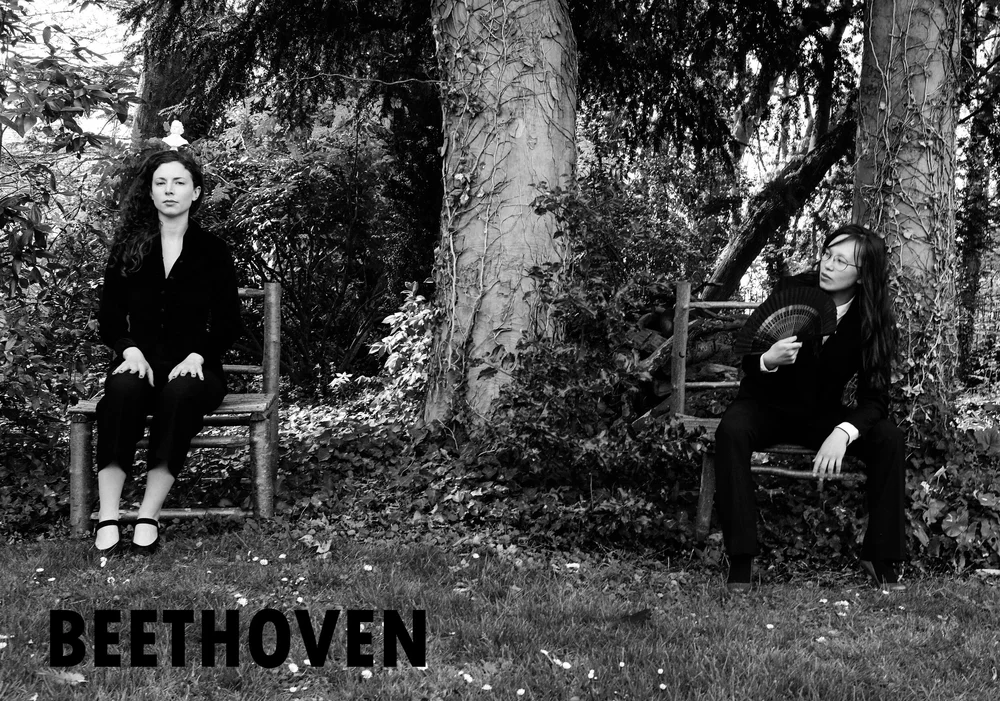
In collaboration with Naomi Woo
In 1974, Pauline Oliveros collaborated with her friend Alison Knowles on a series of postcards containing witty declarative statements such as ‘Beethoven Was a Lesbian’ and ‘Brahms Was a Two-Penny Harlot’. This ‘postcard theatre’, as they called it, took cynical aim at the marginal status of women in music and demanded an alternative proposition. Sent to friends, the postcards remind us of mail art and event scores, but importantly also become extensions of feminist and queer community, then and now. Seita and Woo take Oliveros and Knowles’s ‘postcard theater’ as an invitation to reinvent their photographs and texts as scripts for performance. These postcards also lead them to other queer women who join them in a musical and poetic séance.
Through playful dialogue and promiscuous citation, the performance seduces the tropes of classical music in order to dominate them. Performers conduct and are conducted, listen, flirt, sing, play, recline, read, die tragically, and bask in the soprano’s voice.
This piece forms part of Woo and Seita’s ongoing collaboration, which re-imagines and translates the work of neglected historical female and queer artists, musicians, writers, and philosophers into experimental performances that blend music, poetry, research, and live art. Between lecture-performance and love letter, their performances forge an imagined collective spanning varied cultural, historical, and linguistic backgrounds. These works reflect on borders, being seen or obscured—on screen and off, taking up space in language and with one’s body, oppositions in pendulum, on keeping time, dwelling on words, what eludes our perception, what we can and can’t grasp, and how to stay awake to the mist.
performances
The Queer Art of Feeling, symposium, New Hall Cambridge (2019)
Café Oto, London (2022)
photos
Laura Cobb
sound piece
Harvard University, 31 Mar 2021
Tete a Tete, Opera Festival, London, Aug 2020
We recommend listening to this piece with headphones. This is the script/libretto and here’s a handoutof sources.
press
The Wire (Dec 2020)
I Care If You Listen (Oct 2020)
Jacket2 (Apr 2021)
postcards
Double-sided matte, 105mm x 148mm

performative gloves — digital print on polyester
Vulva's School: A Fucking Didactic Take on Experimental Feminist Performance Art, or, How to Read is a performative lecture that thinks about (and through) Carolee Schneemann, Hito Steyerl, Judy Chicago, Jack Halberstam, Gordon Hall, Lisa Robertson, Gertrude Stein, Maya Deren, Sianne Ngai, and Eve Sedgwick. It’s also a piece about teachers of reading, about alternative forms of learning and relating, about abstraction and autobiography, about pinched nerves, about visibility, about vulnerability in institutions, about detours, about getting lost, but also about professional slickness, and as always (always) about serious copying and necessary (even relentless) repetition.
performance
JNU, New Delhi, India (Jan 2020)
Florens Cargo, Darmstadt, Germany (Aug 2019)
University of Cambridge (Nov 2018)
photos
Laura Cobb, Nathalie Bohländer, Ayla Hübner (2019)
video
Commissioned by Sarah Hayden and Queer Art Projects, for WIP, digital exhibition, 15/20/20-15/01/21, funded by Arts Council England. Curatorial note here (click bottom left icon) and artist statement ‘Reading-in-Progress’ here.
press
e-flux (2020)
Kunstforum International (2020)
Bagri Foundation (2020).
Berlinale Shorts (2020).

Humanities, Provocateur: Toward a Contemporary Political Aesthetics, ed. by Brinda Bose (Bloomsbury, 2021).
How can the humanities make an intervention in such a time as this, when life as we have known it hangs in pandemic balance since the spring of 2020-and when contagion calls for distancing and isolation, while loneliness cries out for the solace of touch? Perhaps only by being, at once, fearless, critical, sorrowing, exultant, enraged, intimate.
Humanities, Provocateur brings you fourteen essays and two creative pieces by established as well as younger scholars and writers from America, Europe, the Middle East, South Africa and South Asia, in a bracing invitation to a freefall of reading. They travel from classical literatures and philosophy to twentieth-century writing, cinema and critical-imaginative thinking, grouped whimsically around a set of provocations-Gleaning, Perforation, Caprice, Paraphernalia, Descent, Flux, Flesh, Ephemera-and welcome you to argue, to cherish or to distrust. Taking sharp, sparkling twists and turns in thought and style, this eclectic collection of writings incites you to be intellectually adventurous and destitute at the same time. And, invoking Dante, to never be afraid, for our fate is our gift.
Chapter Contribution: ‘Vulva’s School’: Toward a Provisional Pedagogy’.
Cover Image: Performance of Vulva’s School at JNU, January 2020. Photo: Santasil Mallik

Kate Clayton and Sophie Seita met in a small cafe on an empty Keralan beach in December 2019. A mutual interest in literature, laughter, reading, and queerness led us to discuss the possibility of collaborating. From our respective homes in the first lockdown in 2020, we slowly began to dig out the shell of a project and created two artistic personas to help us in our experiment. Compost became our metaphor for intergenerational dialogue. For transformation. Compost is a re-interpretation of the earth to create a new form. A fermenting. A digesting. The earth eating itself. Compost creates new life by killing old life. Pearl (Kate) is the character who oversees this process. Theory (Sophie) is the artist-as-researcher who contextualises, conjectures, cites the veritable Authorities to get a little closer to the gist of the matter. Eventually, Sophie might shed the Mask of Theory, which is her mascot and burden. Pearl believes in the need to live and let live. They are together in this breeding ground for novel ideas.
Sometimes Pearl feeds the compost some lines of pearl-poems under the direction and instruction of Theory. Getting down and dirty with compost also means facing hard truths, grappling with the cloudy, the mucky, the muted. An experiment in touch as knowledge. A different kind of sensuality. Healthy compost consists of alternate, complementary layers. Old habits and behaviours need to go into the bin to be transformed by a feasible and sustainable way forward and a new politics of care. In a time of precarity and isolation, Pearl and Theory move through what they have in common like insects move through compost. Guided and prepared by theoretical reflection, the soil and materials they bring into bed allow them to dig into rich layers of reality, chewing, chewing, chewing, to spit out new ideas.
The project led to some R&D time on the Isle of Bute, supported by Creative Scotland and a-n, which focused on extinction, mortality, futurity, and making work in a rural context, in light of climate change.
screening and performance
Hundred Years Gallery, June 2021
Womxn Performing Selves, Internationales Frauen* Theaterfestival, Frankfurt, video installation in ‘Pandora’s Box’.
photos
Laura Cobb (performance) and Kate Clayton/Sophie Seita (video stills and process photos)
press
SPAM Plaza (2021)
funding
Creative Scotland, Open Fund (2021)
a-n: Time Space Money (2020 and 2021)

In collaboration with Simone Kearney
Desire Lines follows the lines and orientations of Sara Ahmed’s book Queer Phenomenology (2006). In this performative translation of Ahmed’s work into movement and material, Sophie Seita and Simone Kearney are uttering the text across space, at oblique angles, with delays. Materials and props included clay, paper, projections, string, a table, two chairs.
‘We could ask, for instance, whether queer tables are the tables around which queer bodies gather.[…] The table might be the site upon which queer points can be made. [...] there is something rather queer about furniture. [...] We furnish space with “movable objects”. [...] movability is a condition of the meaning for furniture. You can move the table, here, there, into the corner of the room; in a sense the purpose of the table relies on your capacity to move it around. [...] yet I think that is a misrecognition. Instead, the table follows you around. The table is an effect of what it is that you do. [...] Queer furnishing is not, therefore, such a surprising formulation: the word “furnish” is related to the word “perform” and thus relates to the very question of how things appear. Queer becomes a matter of how things appear, how they gather, how they perform, to create the edges of spaces and worlds.’
—Sara Ahmed, Queer Phenomenology, p. 167
performance
Raven Row, London (2019)
Kilachand Honors College, Boston University (2020)


Out of print
Thinking about lines now.
Thinking about lines now.
Thinking about lines now.
Thinking about lions now.
Thinking about lie-ins now?The reader says
lots of words sound like
other words
“Sophie Seita’s Fantasias in Counting furthers an evolving, intense and remarkable body of work with performative textuality, spatiality and ethics of presence. Her poetry and poetics test the very limits of prosody; her theatrics work the defamiliarised into the known: a fantasia of the writer’s making defaulting into non-ownership. Rhythm and its predications and failures are central to ‘speech’. Seita writes: ‘[Begins to play a rhythm on or with scattered sounding-material—whatever is available. Ideally, this is a polyrhythm or cross-rhythm, either 4:3 or 5:3, or even better 4/4 : 4/3 or 2/5 : 2/3 or something of that kind; over the repeatedly spoken phrases: no I cannot; no you cannot (ad lib with pleasure)].’ The rhythm becomes word becomes the ‘theatre’ itself. At first experience a viewer, a reader, a fly on the wall, might undergo the epiphany of the ‘new’. But in Seita’s melding of ancient and modern performative techniques, her investing the moment of articulation with an awareness of the social and political constraints it operates within, we actually start to question what is ‘new’. Rather, we might apply to her work something akin to Stravinsky’s observation that Beethoven’s Grosse Fuge was ‘absolutely contemporary’ and would remain ‘contemporary forever’. Sophie Seita is one of a handful of brilliant ‘new’ poets and performance-enhancers who are changing and will continue to change how we receive and resist the ‘limits’ of poetic form and performative spatiality. She creates texts that are investigative and synaesthetic. When we read ‘my theory is better than my praxis’, the irony ripples through the manuscript, because rarely do the metronome, the drum beat, the tones of voice resonate so strongly. The page becomes the acoustically desirable space, with all attendant ironies and wit. Character and writer are of no fixed address. Sophie Seita is a writer of genius who will never stay still, who will constantly work the boards in ways as yet unimagined. Watch, listen, and be changed.”
—John Kinsella
“Appearing in the drag of scale exercises, wrought and precise conceptual variations, and playful improvisation, the performance scores in Sophie Seita’s Fantasias in Counting might cause their readers/audiences to wonder whether they’re clothed or nude. Yet the pleasure of these works is their refusal—tartly apropos our digital times—of such binary codings: countable v. mass nouns, wholes v. parts, the one v. multiples, original v. proxy, integer v. fraction, feigned v. felt, and, perhaps most importantly, repetition v. difference. For while Seita’s jargonate arias may instrumentalize the count of the metronome, they also “ambivalize” to reach an “acchord” or “communichord”; remaining unaccountable to a beat, they transmogrify uniform temporal divisions into the bumpy, opaque spacing of socio-linguistic relations. In Steinian tradition (“a craving so little as that like as if it (then) would be then it would be simple. simple and countable. more simply countable. a slice please. much cream.”), Fantasias in Counting effects, against the preterit, new performative grammatical modes: “cannot be counted, only done,” “practised, not counted.” Likewise, the book forges forced ways of being among languages: Seita does not just notice how “lots of words sound like other words” but stages language in states of “hyperarousal,” finding, for instance, an opera within an opera by unfolding a narrative spelled by its paratextual musical directives cum characters: “Po may be generally slow or fast at wasp-speed.” “The subversive subject has lost. Now only irrational measures,” Seita writes, but perhaps that subject is not so much lost as distributed both within and without itself, just as protagonistic or quantifiable models of action have here fissured into mischievous, disturbing agencies, even the agency of aporia. Here’s more than “A little ‘hey’ for true mathematics”: “Please take some time with this line.”
—Judith Goldman
Scene I
[DE LEMPICKA’s decorous parlour. A long dining table, no chairs. To the right, a dressing table, to the left a floor-length painting that looks like a mirror. DE LEMPICKA wears a flashy grey table-cloth intricately wrapped around her intricate body.]
publisher
BlazeVOX
press
May 2015 Tears in the Fence
May 2015 Poetry Foundation/Harriet
June 2014 Bookslut
You land on the first note, like a sigh. Sophie Seita, Bio, News, Work, Colophon. Dripping, or skipping, as if walking down stony stairs, with a spring in your step. The background is beige or sand. If you hover over the words, they react to contact, as if their surface had been stroked or brushed, they become italic, and at that moment, the little hand appears, no longer an arrow, but a glove that points and grasps, gently. You click and the cascade unfolds. Works tumble down and scatter, as if on invisible lines, threads, staves, or strings, testing distance and proximity. If you zoom in, you’ll see slight specks, transposed from the natural cotton fabric I have in my studio. You click again and a project unspools itself, becoming the pivot, while leaving the other works visible, holding their poses on their assigned positions. The background changes colour. Touch activates change.
This website has been conceived as a score; that is its working metaphor. What this means is that it both documents—but also leaves room for—performance, for activation, or is itself a verbal-visual-sonic object, combining different senses.
Some drawings and symbols used in other projects have been turned into functional icons:
For any audio on the site, you find an abstraction of lips, which flip up when sound is playing.
For image descriptions, you tap the three wavy lines that signify fog or mist in my system of notation; the lines tilt, now vertical, like an arpeggio, a chord broken up into its individual notes.
For opening and closing a section, there’s a little squiggly symbol which looks like a walking stick crossed with a lightning bolt, but it’s actually a direct, or guida in Italian, indicating the next musical note on the following staff or page, like a catchword in mediaeval manuscripts.
This is an experimental audio description and a work description, a revealing of process. A process of percolation. Or scaffolding, where, as I say elsewhere, the thinking of the building is on display. So, for example, the open-source fonts are Linux Biolinum and Linux Libertine. Alongside the score, these were other metaphors I toyed with, and while they did not materialise in the design, they vibrate at the back of my thinking and making:
—the website as paper boat
—the website as a garment that conditions movement
—the website as a plastic bag with a stone on top, cradled and squeezed by two hands (like Lygia Clark's sensorial object Stone and Air)
—the website as a book you can step into like a sculpture
—the website as the brainchild of the Rococo and Minimalism
—the website as a set or stage for suspended attention, reading and listening with your back turned, aslant, with your elbow, as if there was a line of connection between its bones and the soft diamond-shaped hollow of your knee
I’m telling you all this because I think of this website not as a sealed container or prefabricated shelving unit, but something that is made by someone, in this case, Aidan Quinlan, in conversation with me. And that something is playfully provisional.
This concludes the colophon, typically used at the end of a book to give additional information about a publication. The word comes from the Greek, ‘finishing touch’. Underneath, there’s a drawing of the spinal cord inside the spinal column, which aptly looks like the pages of a book held open by many tiny hands.






































